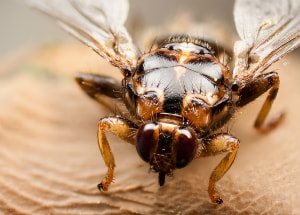When the warmer seasons come around, new, annoying guests start swarming your household, camping site, and vegetable patches. Mosquitoes, flies, and gnats become more and more active, breeding rapidly and infesting the area. ‘Flies are harmless’, you may say. Well, not really.
Flies and other winged pests can be a real threat by contaminating water, harming crops, and even spreading disease. Dealing with them is not the easiest task you can burden yourself with. The insects are very resilient and hard to bring down, even with the most toxic treatments. For this, let’s take a look at what repels flies for good.
[amazon table=”11643″ tracking_id=”best-fly-repellent-20″]
Top 5 Best Fly Repellent Products You Didn’t Know You Needed
- Sawyer Products Picaridin Insect Repellent – My Top Pick
- Ultrathon Insect Repellent Lotion
- Absorbine UltraShield Fly Spray
- Mintronella Farm Raised Candles
- Murphy’s Naturals Repellent Candle
If you have come this far, you might have a real fly problem, or you’re simply trying to avoid one. Anyway, the market is full of treatments that can help reduce the chances of fly infestations, crop-damaging, or completely stop fly-borne diseases. The problem remains that not every treatment actually works.
In this section, I’ve prepared a concise yet comprehensive list of products that are as effective as it gets. Each of them is a unique solution for various fly-wise situations. These fly repellent reviews contain a list of upsides and downsides that you might want to consider. Shall we?

My Top Pick:
1. Sawyer Products Picaridin Insect Repellent — Best Outdoor Fly Repellent for the Whole Family
[amazon box=”B01M5JGO4P” template=”vertical” tracking_id=”best-fly-repellent-20″ button_text=”Check price on Amazon”]
Specifications:
- Active Ingredient: Permethrin
- Item Volume: 1 Quarts
- Item Form: Lotion
- Product Dimensions LxWxH: 5 x 2 x 9.25 inches
- Target Pests: Biting Flies, Stable Flies, Gnat, Chiggers and Sand Flies
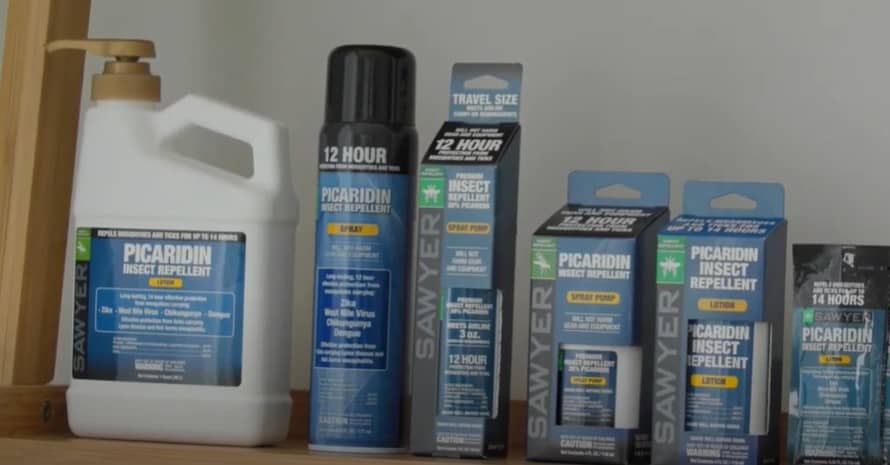 Among the variety of products you can find online, in my opinion, this one is truly the best fly repellent. The treatment is elaborated using Picaridin, which is considered one of the most promising pest toxins today. It’s an active ingredient extracted from plain pepper.
Among the variety of products you can find online, in my opinion, this one is truly the best fly repellent. The treatment is elaborated using Picaridin, which is considered one of the most promising pest toxins today. It’s an active ingredient extracted from plain pepper.
Surprisingly, insects, especially flies, are extremely repulsed by the smell of the substance. Upon direct contact, it harms the insects’ nervous system, making it unstable and causing paralysis. As a result, the victim dies almost instantly.
This product contains around 20% of the chemical, which increases its effectiveness and prolongs the use duration. When applied to an area or clothing, the product stays active for more than 10 hours. Such an extended time is sufficient for a thorough treatment of mild and harsh cases of infestations.
Though the spray causes lethalities to insects, it’s still one of the safest solutions for humans. Picaridin is harmless for people and animals since their nervous system is more resilient and stable than that of an insect. However, I still advise you to follow the instructions.
| Pros: | Cons: |
|
|
2. Ultrathon Insect Repellent Lotion — Great Camping Flying Insect Repellent
[amazon box=”B00KXB3QWU” template=”vertical” tracking_id=”best-fly-repellent-20″ button_text=”Check price on Amazon”]
Specifications:
- Active Ingredient: DEET 34.34%
- Item Form: Lotion
- Item Weight: 7.4 ounces
- Product Dimensions LxWxH: 9.5 x 7.2 x 4.6 inches
- Target Pests: Biting Flies, Mosquitoes, and others
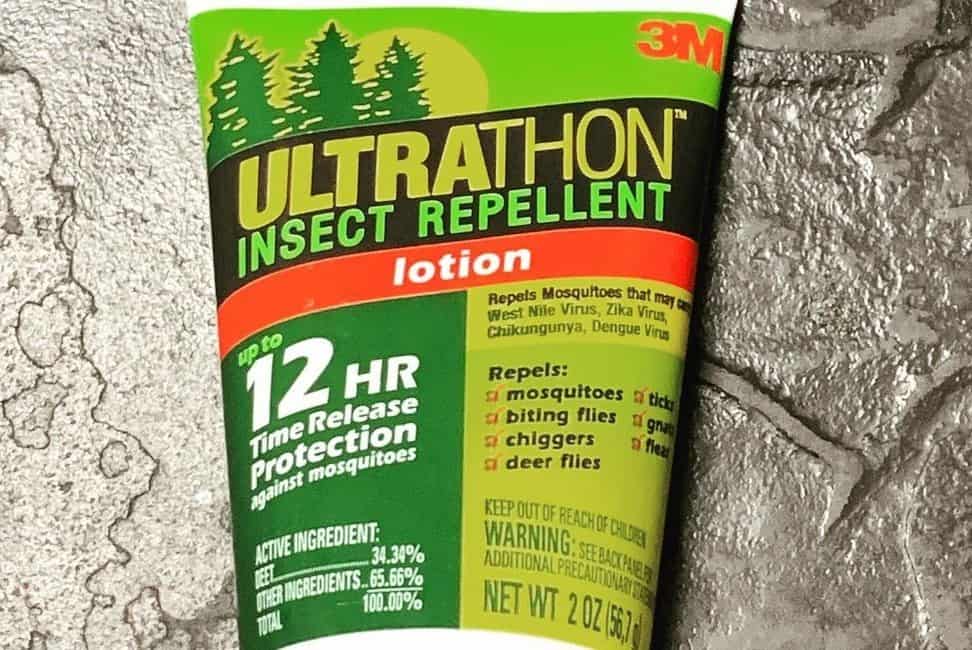
If you would rather not use a spray due to its volatility, you might want to consider applying a lotion. The Ultrathon Repellent is an effective and comfortable treatment for camping and hiking. Just spread the product on your vulnerable areas and let it soak in a little to see the results right away.
With the main component as DEET, the product is an acclaimed anti-fly lotion. DEET is known for its anti-pest properties due to its unfavorability towards an insect’s senses. First of all, the ingredient is appalling for insects, which makes them avoid any contact with the source.
Second, the component can influence an insect’s senses by depriving them of smell, hearing, or taste. This sends an alarming signal to a pest, driving them away from the user.
As the best fly deterrent, the product is very easy to use. By spreading it over vulnerable areas, you ensure safety and protection for over 12 hours. Also, it has no expiration date, so it can last for more than one season.
| Pros: | Cons: |
|
|
3. Absorbine UltraShield Fly Spray — Best Fly Repellent Spray for Horses and Dogs
[amazon box=”B000MD3N5E” template=”vertical” tracking_id=”best-fly-repellent-20″ button_text=”Check price on Amazon”]
Specifications:
- Active Ingredient: Permethrin
- Item Form: Liquid
- Item Weight: 8 pounds
- Product Dimensions LxWxH: 16.12 x 7.62 x 13.75 inches
- Target Pests: Flies, Ticks, Mosquitoes, Fleas, Lices
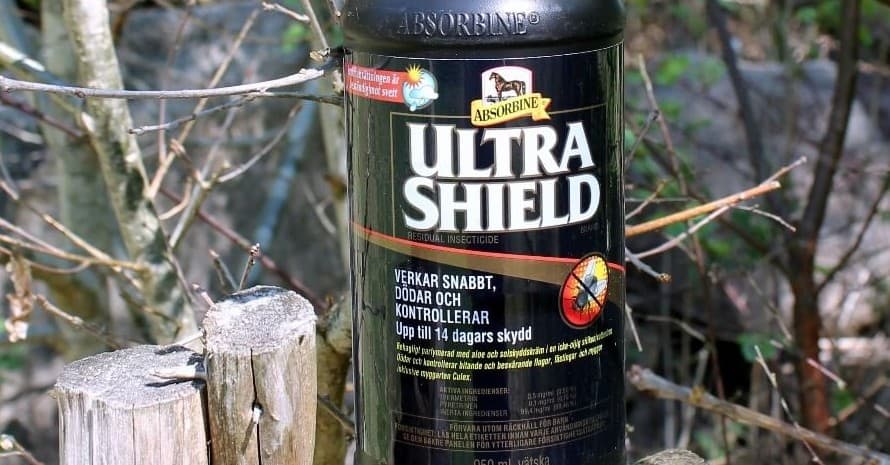
Make sure to apply this product if your ‘fly’ concerns move beyond personal use. It’s great for large and medium-sized animals, like horses, sheep, and dogs. Safe and animal-friendly, there is no better solution for your household.
The treatment works both as a repellent and sunscreen. As for the first one, the active ingredients used in the formula act as a deterrent to prevent gnats, flies, and mosquitoes from coming any closer to your farm animals. If they do, the formula extermines the intruders, stopping them from causing any discomfort or any harm.
As for the sunscreen, the formula includes Aloe and Lanolin. Both of them help protect a horse’s hair from violent UV rays and provide a soothing effect in case of inflammation or bites. This organic fly repellent doesn’t require watering-down or any prior preparations. Just fill in your spray tank and apply it to your animals’ skin or infested household areas.
| Pros: | Cons: |
|
|
4. Mintronella Farm Raised Candles — Best Natural Outdoor Fly Repellent
[amazon box=”B083ZH5DH2″ template=”vertical” tracking_id=”best-fly-repellent-20″ button_text=”Check price on Amazon”]
Specifications:
- Scent: Mintronella
- Material: Bamboo
- Item Form: Stick
- Item Weight: 6.7 ounces
- Product Dimensions LxWxH: 12 x 2 x 1 inches
- Target Pests: Mosquitoes, Gnats
Besides sprays and lotions, there are other products helpful for insect treatment. Oil-infused incenses by Mintronella can save your time, money, and health while protecting the area round-the-clock. Compact and efficient, these patio fly repellents are harmless to the environment and pleasant to the smell.
The pack consists of almost 8 dozen candles where each incense can last for around 50 minutes. This time is enough to fill the air with natural essences and smells that flies find extremely unpleasant. Containing Citronella, Peppermint, and other plant-based extracts, the product is meant to prevent pests rather than exterminate them.
To apply the treatment effectively, place the sticks around an area. Usually, two or three of them are enough for one-time use, but the number may vary depending on the footage. Ignite the incenses a few minutes before entering the area and let them burn until the product is completely burnt down.
| Pros: | Cons: |
|
|
5. Murphy’s Naturals Repellent Candle — Best Citronella Candle to Repel Flies
[amazon box=”B0753JKZ19″ template=”vertical” tracking_id=”best-fly-repellent-20″ button_text=”Check price on Amazon”]
Specifications:
- Scent: Cedarwood, Lemongrass, Peppermint, Rosemary, Citronella
- Material: Soy Wax, Beeswax
- Item Weight: 1.66 Pounds
- Product Dimensions LxWxH: 6.6 x 3.3 x 3 inches
- Target Pests: Mosquitoes
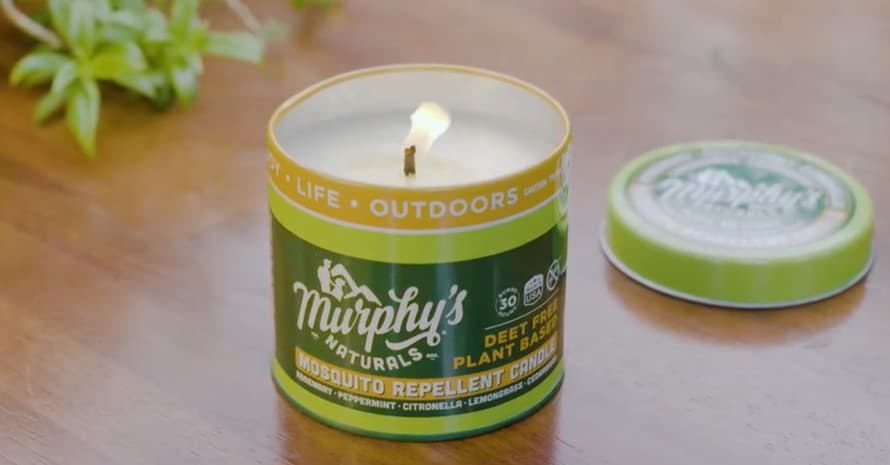
This citronella candle is great for conducting a nice anti-fly treatment routine inside your house both for their prevention and extermination. The product is an eco-friendly 9-oz candle infused with Rosemary, Lemongrass, and other essential oils, possessing extraordinary repelling properties.
Designed and produced in the States, the treatment is a fly repellent candle, mainly utilized for indoor maintenance. Since it doesn’t contain any chemicals or synthetic components, it’s completely safe for people and animals. It causes no allergic reactions or airway irritation, which so often happens with toxin-based insect repellents.
Place the candle in the bedroom or living room and keep the windows open. There is no need to leave the area for the time being. Contrastingly, it’s completely normal to have the candle lit while sleeping as the oils possess therapeutic properties.
| Pros: | Cons: |
|
|
Buyer’s Guide

Purchasing a fly repellent spray for humans or animals is one thing, but knowing how to do it right and how to use it is something different. Each product is unique. With its composition, effect specifications, and use techniques, there is always more to learn to make the best out of it.
How do you know whether you can apply an organic, non-chemical treatment, or when to turn to heavy-duty chemicals? How to make sure that your repellent won’t go to waste by soaking into the ground too deeply? Let’s consider more and have a detailed insight into these questions.
How do fly repellents work?
Depending on the composition and formula, different repellents have rather various effects on both the pests and humans. When talking about classic, chemical-based treatments, the properties that make them effective are of two types.
First, a repellent is meant for prevention. Extracts from plants and flowers provide the treatment with the ‘alarming’ function. It warns insects about a possible danger, utilizing smells and scents that are unpleasant to them.
Second, if the first feature doesn’t work, and an insect comes too close to the skin, chemicals, and toxins harm the insect’s sensory and nervous systems. As a result, the fly is either neutralized for some time or completely eliminated.
How to choose the best fly repellent?
When considering a repellent, you stumble upon a variety of products. They can come in all kinds of forms and sizes, with different components, and specifications. To make a good choice, find the most suitable flying insect repellent, make sure to mind the following.
Active ingredients
All the treatments can be divided into synthetic and natural products, like Citronella, Peppermint, etc. The synthetic ones are most widely spread since they are cheaper and easier to manufacture. They can contain quite a few ingredients that enable a repellent’s preventative and exterminatory functions. However, the most popular ones are DEET and Picaridin.
DEET
Deet has been around for over 60 years and proven to be an effective measure of pest treatment. The chemical’s main goal is to deter flies and other insects and make them avoid any contact with the skin. It can be used both for children and adults and is extremely eco-friendly.
A stable fly repellent for humans normally ranges from 20 to 40% of DEET. Even though a high concentration of the substance may ensure better protection, it’s not always the case. For example, repelling regular flies usually requires a 20% DEET-treatment.
Picaridin
On the other hand, Picaridin is aimed at having a more lethal effect on flies and pests. The component derives from black pepper and is synthetically mined as an extract. Such a process makes it extremely concentrated, thus deadly for insects.
To influence an insect, the ingredient actually has to get into the fly’s digestive system. When soaked through the blood vessels, it interacts with the nervous system, inflicting movement, and breathing difficulties. This results in paralysis and, eventually, in death.
Though it’s quite harmful to insects, Picaridin doesn’t have the same effect on humans or animals. Because mammals are normally bigger and have accelerated metabolism, small quantities of Picaridin are unnoticeable to our bodies.
Types of repellents
The variations of forms and application of active ingredients are numerous. Though you might have got used to typical sprays, there are even more products that can protect from flies. If all the CDC guidelines have been complied with, each of them becomes a potentially safe fly repellent. But which type to choose?
Sprays
These treatments are commonly used by people who are into hiking, camping, etc. Applying a spray is as easy as it gets. Moreover, it provides the skin with necessary hydration and can cover more body areas with a single press. However, it gets onto clothes and is not very resistant to water.
Lotions
To make your repellent application more local, you can get yourself a lotion. These products allow the user to choose the application areas, which they consider the most vulnerable. Being a great natural outdoor fly repellent, a lotion is mainly made to be water-resistant, thus being suitable for long hiking trips and simple forest wanderings. On the downside, lotions can be waxy and sticky.
Electronics
If you’re concerned about your property and there is an infestation coming around, electronic fly repellents can do the trick. When installed at your household, the appliances can guarantee non-stop protection around the perimeter. Moreover, they are chemical-free and don’t irritate pets. But mind that you cannot take one along on a trip.
Candles and incenses
For those cases, when you want to use all-natural treatments, candles and incenses can be a real solution. The products are made of essential oils and, normally, don’t include any chemicals. You can place them in the kids’ room or bedroom since this type is a great natural fly repellent for the house.
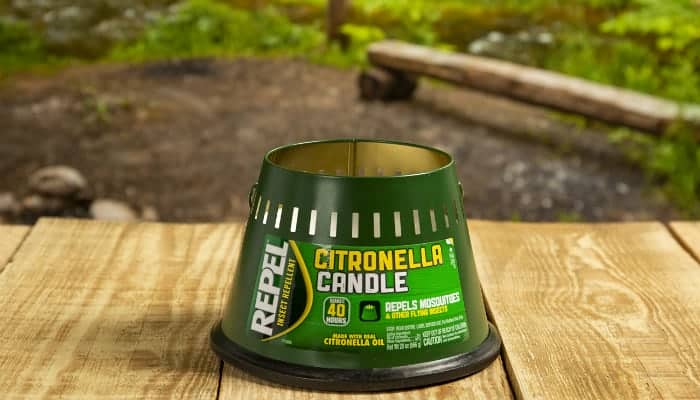
How to use repellents effectively?
Obviously, a good result after using a repellent doesn’t solely depend on the composition of a treatment. There are lots of factors increasing or decreasing the efficiency of an applied solution. Let’s take a look at the most important aspects to pay attention to when using insect repellents safely and effectively.
Distance
When applying your solution, specifically sprays, make sure to keep a sufficient distance to your skin. The recommended space between your skin and a spray should be approximately 5 to 7 inches. Why so? Because such a distance eliminates the chances of spreading the fumes excessively, thus causing the spray to get into the airways.
Clothing
Before spraying a solution, it’s advisable to assure yourself that the soon-to-be-covered areas are free of clothes. If the fumes get onto your clothing, they might leave stains, which are extremely hard to get rid of. Moreover, the spray deposits in the fiber. When deposited, there is a later possibility of touching your sensitive areas, thus irritating the airways or causing inflammation.
Injuries and scratches
If you cover bare areas of your skin with a spray or a lotion, check for cuts, scratches, and other injuries. It’s dangerous for a repellent to get into vulnerable areas since it can soak through the thinnest skin and travel through the bloodstream. Should it get there, it can lead to intoxication, allergies, and even poisoning.
Safety
Of course, such treatments are meant to be harmless, but even the best outdoor fly repellent can be quite dangerous when applied wrongly. For this, try to cover your eyes, nose, and mouth when spreading the solution. If it’s not possible, make sure to turn your head aside for around 15 seconds so that the fumes can settle down on the skin.
What if…?
In case the repellent has got into your eyes or nose, it’s necessary to apply fresh, cool water to the areas. Sprinkle a few drops into the eyes and try to get the treatment through tearing or rinsing. The same should be done for the nose and eyes so that the particles don’t get into your airways and digestive tract. If the procedures didn’t work, you should contact your physician to avoid irritation or poisoning.
FAQs:

Let’s take a look at some questions that you might still have about repellents.
Do citronella candles repel flies?
Yes, they do. In fact, citronella, peppermint, and lemongrass are the most effective against a whole range of pests, like gnats, mosquitoes, fleas, and even bees.
Are flies repellents safe?
Using a repellent in the form of a spray or lotion is completely harmless unless you don’t follow the instructions. If you take precautions and take care of the way you apply a treatment, there should be few to no dangers.
How to make a fly repellent at home?
Making a natural fly repellent for the house is quite easy. You’re going to need some essences, like lemongrass, peppermint, rosemary, etc. Concoct a few drops of them with 20grm of vodka and half a cup of water. Apply the treatment to plants and the patio.
Can I use a mosquito repellent to repel flies?
Well, yes. Picaridin and DEET are very versatile.

Why Bother if You Can Spray?
Every problem has a solution, but every solution requires actions. By employing a good repellent against different pests, you can save time, money, and a lot of nerves. In this way, dealing with flies can become less of a worry and more of a hobby.
Nevertheless, I hope you’ve found this article useful. Now, it’s time for you to tell me a few words about your fly repellent experience. What kind of treatments do you prefer? Which one do you find more effective against cattle flies: Picaridin or DEET? Make sure to leave your comments down below!
References:
- Insect Repellents Topic Fact Sheet (Oregon State University and the U.S. Environmental Protection Agency):
http://npic.orst.edu/factsheets/repellents.html - Picaridin General Fact Sheet (Oregon State University and the U.S. Environmental Protection Agency):
http://npic.orst.edu/factsheets/PicaridinGen.html - Using Insect Repellents Safely and Effectively (United States Environmental Protection Agency):
https://www.epa.gov/insect-repellents/using-insect-repellents-safely-and-effectively

